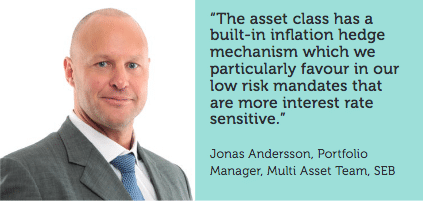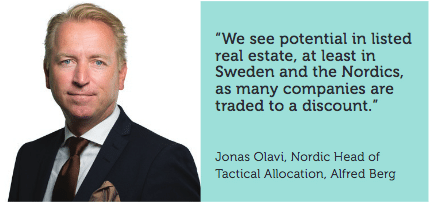Real estate and infrastructure investments have been on the rise among institutions in the Nordics and elsewhere in recent years. The hunt for income producing assets and an attractive yield gap on real estate investments given ultra-low interest rates are factors playing into the demand picture. But how are Nordic allocators viewing this
exposure currently, HedgeNordic took the pulse on three Swedish institutional investors.
Talking to Jonas Olavi, Nordic Head of Tactical Allocation at Alfred Berg, Jonas Andersson, Portfolio Manager, Multi Asset Team at SEB and Ulrika Bergman, CIO of the Nobel Foundation, we wanted to find out how they view real estate and infrastructure from a portfolio perspective, if and in what way allocations have changed over time and how they look upon the risk of significantly rising interest rates for the asset class.

HedgeNordic: How do you look upon real estate and infrastructure in your asset allocations. Do you view it as a separate asset class or as part of the alternatives bucket?
Jonas Olavi: We view real estate investments as part of the alternative investment bucket, both via the exchange and as direct investments.
Jonas Andersson: When discussing this I will refer to listed companies in the infrastructure sector. We do not currently have real estate as part of our model portfolio. As we defined our portfolio classifications listed infrastructure eventually arrived in the equities risk bucket although we know that it is a separate asset class with specific characteristics. From a risk management standpoint, we could finance infrastructure with ¾ equities and ¼ fixed income given a risk neutral approach.
Ulrika Bergman: We view infrastructure and real estate as a separate asset class.
HedgeNordic: What added value do you see with the asset class?
Jonas Olavi: These investments lower the risk and adds to the risk adjusted returns of a well diversifiedportolio. Real estate and infrastructure investments share some common traits that makes them valuable from a portfolio perspective. They enjoy a stable return profile over time, they show little correlation to other asset classes and are not so sensitive to changes in economic conditions. If you invest in real estate investment funds you will be affected by market sentiment but still own an asset that shows lo w correlation to the equity market, the reason being that the asset class has steady cash flows and are viewed as a defensive investment.
w correlation to the equity market, the reason being that the asset class has steady cash flows and are viewed as a defensive investment.
For an institutional investor, there is normally additional added value using direct investments in real estate and infrastructure given that it gives you a higher expected return to compensate for the fact that these investments are illiquid. As the Swedish real estate companies are valued today you actually get a discount instead buying them on the exchange.
Jonas Andersson: The asset class has a built-in inflation hedge mechanism which we particularly favour in our low risk mandates that are more interest rate sensitive. On top of this, the asset class offers high dividends and growth in a longer-term perspective. The asset class has a low downside correlation to bonds. There is also an interesting diversification within the asset class where some assets are more sensitive to GDP changes than others. Even though we refer to listed companies within this context, the sector displays lower volatility than the overall market.
Ulrika Bergman: We hold real estate and infrastructure as diversifying components to other traditional asset classes in our portfolio, ideally it will provide us with good risk adjusted returns.
HedgeNordic: What do you see as an appropriate portfolio weight for the asset class over time?
Jonas Olavi: In our model portfolios, alternative investments have an allocation of around 5 percent allocating between commodities, hedge funds and real estate. The weighting of real estate and infrastructure typically comes in the range of 2,5-5 percent in a broadly allocated portfolio, this is however depending on risk preference and size of investments as well as type of investor.
Jonas Andersson: We have decided to allocate 10-17 percent of the equity portion of the portfolio to the asset class in our low-risk mandates. In other mandates we have not included the asset class.

Ulrika Bergman: We currently have no target allocation for infrastructure as a separate asset class, but we do have a strategic allocation of 10 percent to infrastructure and real estate combined. The strategic allocation is aligned with the Nobel Foundation’s long-term return and risk profile.
HedgeNordic: Have you changed the allocation to the asset class in your investment mandates recently, in what way?
Jonas Olavi: We currently hold a neutral stance to the asset class and this has been our positioning so far this year.
Jonas Andersson: We added the asset class during the summer and have not owned it in recent years.
Ulrika Bergman: We have added to infrastructure during the year.
HedgeNordic: How do you look at valuations in the real estate and infrastructure sector currently?
Jonas Olavi: We see potential in listed real estate, at least in Sweden and the Nordics, as many companies are traded to a discount. As such you get better value for money compared to a professional investor investing into physical real estate.
Jonas Andersson: Certain parts of the asset class we are well aware are considered expensive, such as bond proxies. Talking about infrastructure, these are for example to be found among pipeliners. The entire asset class is also quite expensive right now looking at it from a historical perspective. We hold a concentrated portfolio of around 30 companies with regards to the asset class.
Ulrika Bergman: As for most asset classes today, we see them as relatively expensive, meaning that we hold a careful stance with regards to our allocations.
HedgeNordic: What is your view on the asset class looking forward given potentially rising interest rates?
Jonas Olavi: We think that interest rates will rise going forward but included in that view is that we also see rising inflation which commercial properties are protected against as rents will be adjusted for that. In our outlook for the coming 1-2 years we see moderately rising interest rates which means that we are not particularly concerned given how stable real estate companies are today. The risk is of course that we under estimate the rise in interest rates and its effect on the investor interest for the sector.
Jonas Andersson: If increased interest rates is a result of high growth figures we can live with that, we are however aware that the asset class comes with a certain real interest rate risk.
Ulrika Bergman: We remain cautious given that we see the asset class as relatively expensive.
This article is part of HedgeNordic’s Speacial Report on Real Estate and Infrastructure. Read more here.
